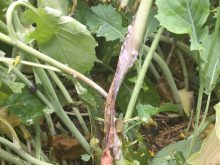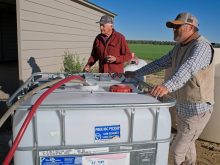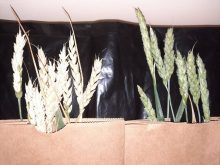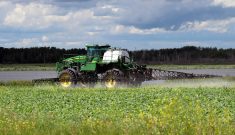Precisely placing individual corn or soybean seeds in a row has led some canola growers to switch from air seeders to vacuum planters in the past few years.
For a fresh look in 2021, Grainews spoke with five Lethbridge-area growers who had experience with precision planting canola in 2020. Two producers carried out field trials through the Farming Smarter organization and the other three already own vacuum planters.
The experiences of the five producers show a strong case exists for using a vacuum planter with canola — but it may be limited to exceptional circumstances. The big factors are whether your farm already has a row crop, whether it has irrigation and the fertility management.
Read Also
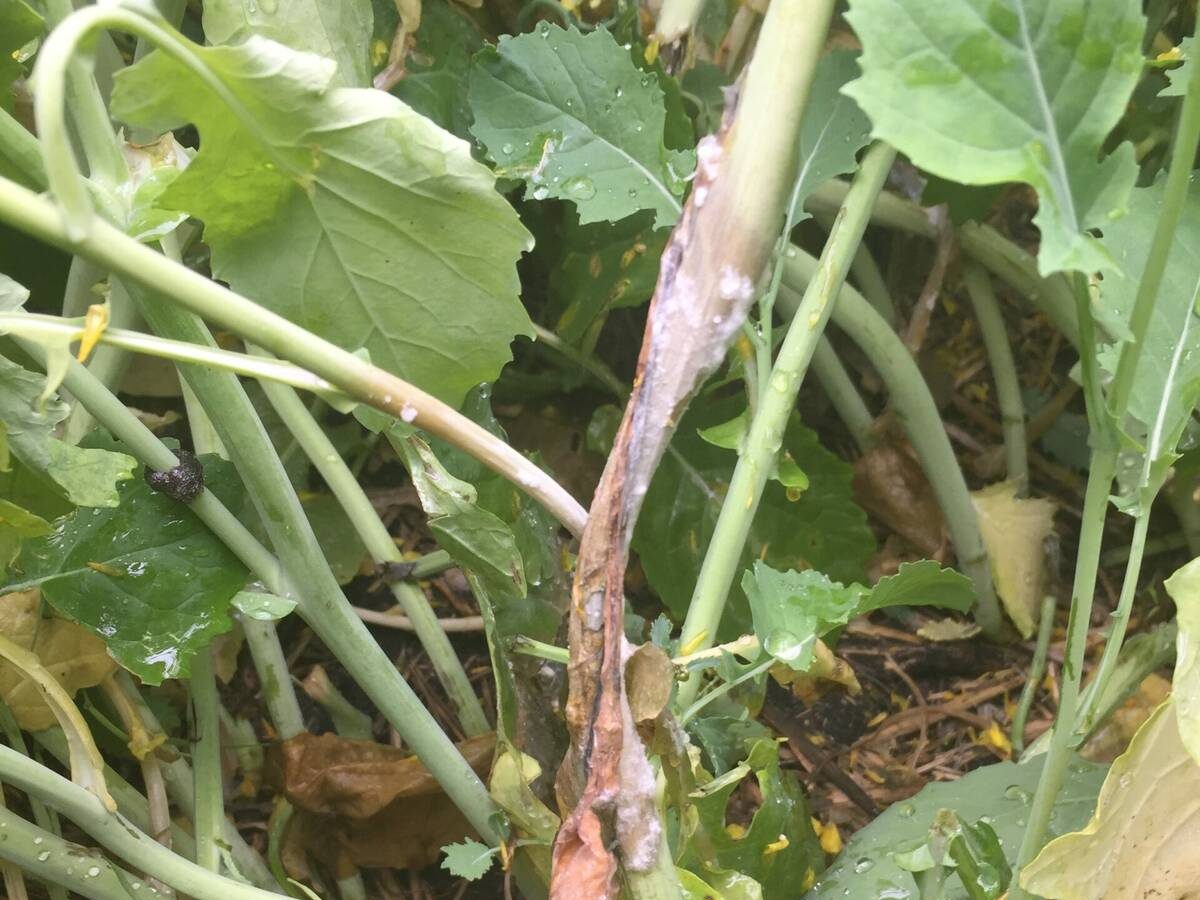
Good news, bad news for fungicides meant to fight stem rot in canola
A report shows overall insensitivity of sclerotinia to three fungicide groups hasn’t changed in a big way between 2010 and 2024 — but shows some sclerotinia populations have been discovered with elevated insensitivity to all three.
Promising results
New Rockport Hutterite Colony at New Dayton and Kolk Farms Conrich Ltd. at Picture Butte each conducted 2020 trials with precision-planted canola. Both farms would like to try it again in 2021. John Kolk is chair of the Alberta Biodiversity Monitoring Institute. Dave Waldner is the crop manager for New Rockport Hutterite Colony, with responsibility for 9,500 acres of wheat, durum, barley, lentils, peas, chickpeas and canola.
New Rockport has a Morris Contour 2 Drill for row crops, as well as an air drill. Farming Smarter brought in a John Deere planter with 12-inch spacing to go against the Morris double-shoot drill with 10-inch spacing and equipped with a side-banding opener. The precision drill did about 30 acres under a 135-acre pivot at rates of one and two pounds per acre. That day, the Morris drill planted at rates of two and 3.5 pounds per acre. The strips were replicated.
“We did the trial to see how low a person can go with a precision drill in pounds per acre compared to our C2 drill and to see what the results would be,” Waldner says. “Conditions for our drill were on the wet and lumpy side. We had to go deeper than we liked to double-shoot the fertilizer. The precision drill was OK. He only had to go down three-quarter (inches).”

Hail on June 13 hammered the whole field at the five-leaf stage, followed by a second shot of hail in early July. Still, with irrigation, the field averaged just under 70 bushels. The precision-placed canola, he says, returned five bushels per acre more than the canola planted with the Morris drill at twice the seeds per acre.
“Our plants compensated for the conditions and grew into bigger plants,” Waldner says.
However, there were significant differences between the systems at emergence and shortly after.
“Normally, we would have waited for good conditions for our drill. I’d like to do it (the trial) one more time under normal seeding conditions. Our drill would perform better than it did but I can’t see how the precision drill could have performed better. The precision planter gave us a nice even stand and almost every seed came up. It was a very good, even stand. Ours was kind of patchy. But, I noticed the vigour was missing on the precision stand at the start.”
The pivot had been in timothy production four or five years. Phosphorus was depleted, and the precision drill only carried seed while the Morris drill was able to band phosphorus with the seed.
Waldner concludes, “The precision planter does a very good job as far as emergence, and you can go with a low (seed) rate. The disadvantage is you cannot put down any fertilizer. I’d like to try it again one more time.”
Better germination, solid stand
Damage from a hailstorm was “pretty severe” on a 40-acre field trial near Lethbridge. John Kolk says, “We still counted plants and had observations but it yielded only 10 to 12 bushels.”
Kolk put his own John Deere 1895 disc drill on 10-inch spacing against a 15-inch Monosem precision planter, doing replications at different rates. He used mid-row banders to fertilize the entire field.
“Overall, I think we had better germination with the precision planter. It was a more solid stand. The precision planter was dropping single seeds at a regular spacing,” Kolk says.
He adds, “At $80 for five pounds an acre, if you can seed twice as many acres per pound, it would certainly cut down on input costs. Starting a crop off right has got to pay you dividends.”
High yields, even spacing, healthier stalks
Many row crop growers in southern Alberta are already committed to the lower input costs associated with precision-seeding canola. As suggested by the Farming Smarter office, Grainews spoke to three producers (including two feedlot operators) who went beyond the field trial stage a few years ago and purchased their own planters.
Four thousand acres under pivot irrigation, about 20 miles north of Lethbridge, supply the wheat and corn silage for the 30,000-head Barrhill Feedlot owned and operated by Ken Van Raay. To provide crop rotation, he grows canola. Around 2016, he purchased a Monosem seeder on 15-inch spacing.
“We do about 1,400 acres of corn with it and probably a thousand acres of canola,” he says. “We do RTK so there’s no overlap. Where a normal canola seeding rate is close to five pounds an acre, we used two to 2.7 pounds of seed per acre.”
Barrhill Feedlot manure provides most fertility requirements for Van Raay’s crops. His team applies up to 40 tonnes an acre on about a thousand acres each fall. They work it in using a conventional heavy disc, then a vertical tillage tool and a harrow-packer.
“That’s where the Monosem really shines,” Van Raay says. “The ground is black and we seed maybe a week later than the regular drills. I’m seeding just under the surface (normally dry) on highly tilled, heavily manured land and, after seeding, we run the pivot. It’s up in two to seven days. I’ve had the canola canopy close in less than 18 days.”
His average canola yield, since getting the Monosem precision planter, has been 73 bushels an acre with yields as high as 80 bushels an acre.
“Canola really likes even spacing,” says Van Raay. “Without having to compete with extra seed, your stalks are so much healthier. Every stalk is the same. I think it may help reduce sclerotinia because there’s much better airflow.”
Van Raay believes, on this land and for his situation, the Monosem is best suited to his needs.
“The Monosem is a very simple and effective planter. It’s all steel and aluminum, with very good hydraulic variable-rate control. The parts aren’t cheap, but it isn’t high maintenance. Once you’re seeding, the operators like it. It takes very little time to change my rates or clean my drill,” he says.
“We’d never go back now to an air drill”
East of Lethbridge, between Coaldale and Taber, Nate Hubbard manages agronomy for the Kasko Cattle Company, which includes five feedlots and 6,000 acres of corn, canola, wheat, barley, peas, quinoa, alfalfa and timothy. Kasko purchased a 40-foot John Deere 1710 precision planter for corn about 2010 and, after modifications, began using it with canola in 2017. The canola is on 15-inch rows.
Hubbard says, “We use it for corn or canola by changing the seed discs inside. We’d never go back now to an air drill for canola.”
Hubbard views the farm as an “ideal” situation for using the vacuum drill with canola. The farm is able to spread manure on most fields every second or third year and is equipped for nitrogen fertigation. About 95 per cent of the farm has pivot irrigation.
“For the seed cost alone, it makes sense to use the planter. We use pretty well half the seed we were before and we don’t have any trouble with mortality in the spring,” he says. “On the planter there’s no more maintenance than on the air drill. We do maintenance once a year anyway for the corn in the fall.”

His canola seeding rate, 220,000 to 230,000 seeds per acre, works out to 2.2 to 2.5 pounds per acre. The yield comes back at 80 to 90 bushels an acre. Corn is taken off early for silage but usually produces 20 to 22 metric tonnes per acre.
“The planter is a lot nicer than the air drill. Every seed (is) perfectly spaced and at the depth it’s supposed to be. Once you have it set, you know your seed is at that quarter-inch to half-inch zone. It’s all in a perfect line, about two or 2.25 inches apart. You never get two seeds side by side. That helps you save on your input cost but doesn’t really affect the yield. You’re not wasting anything — you’re using every single seed efficiently. The canola comes up looking like a cornfield at first because the plants are all spaced perfectly and up at the same time,” Hubbard says.
He now believes the 15-inch spacing is better for canola. Plants seem a little bushier and have more airflow. He adds, “I think the disease pressure is down a little bit because of that (airflow). Weed pressure is a little higher but if you’re spraying on time it’s really no big deal.”
These days, most neighbours with feedlots also have switched to precision-planting canola as well as corn, Hubbard says.
“Now it’s relatively cheap to upgrade your corn planter to a canola planter. If you have a corn planter and you’re not seeding canola with it, you’re making a big mistake. Without corn, you’d probably need to look at costs and expenses (for the planter) but for us it was natural because we needed the machine to plant the corn. It’s a pretty optimal system for canola but fairly expensive if you’re just using it for canola.”
Hubbard also has done a bit of precision-planted canola on dryland. It works, but he isn’t enthusiastic.
“My results with it on dryland haven’t been very good. If you do use it on dryland you have to bump up your seeding rate to almost what it would be with an air drill. The plant does emerge nicer and grow nicer but it’s not as advantageous. For pivots, it’s pretty much the cat’s meow.”
Singulation perfect for canola
“There’s a precision planter for every price range and, considering the features, they are priced way more affordably than a same-size air drill,” says Josh Fankhauser.
That’s why Lamb Farms Ltd., near Claresholm, is going into a sixth season using a 1999 John Deere 1780 precision planter with 15-inch row spacing and section control for precision seeding.
Lamb Farms manages approximately 7,000 acres (about 25 per cent irrigated) with a wide array of crops and intercropping using the old planter plus a newer John Deere 1890 air disc drill.
About 30 per cent of the fields are precision-seeded and intercropped with canola, corn, favabeans, sunflowers and yellow peas. Canola, about 20 per cent of the acres, is planted on both dryland and irrigated acres.
Fankhauser says, “I did a lot of homework before I got my planter. They depreciate very rapidly, so we bought an old one out of the States and built it up the way I wanted it. Planters are like hot rod cars. There’s a million options and you can do all kinds of things with them.”
At first, he used the precision planter for traditional row crops — corn, sunflowers and favabeans. It already had some section control and all-run blockage monitors from the factory.
It was modified later, for canola, with air-adjust row cleaners. Now, air cylinders also separately adjust down-force for the front and back rows of planting tools.
Referring to the John Deere 1890 for small grains, Fankhauser says, “It’s one of the best air drills on the market. But our older and much cheaper planter is far more precise.” It has 32 seed boxes. With just one bag to a box, it can seed a full section without a refill.
He explains, “You’re singulating and every seed is placed perfectly, so every seed grows. Singulation does amazing things to canola. Once the planter is set right, it can do textbook perfect on 95 per cent of the seed. It all comes up on the same day.”
He sets it for seed spacing rather than seed counts or pounds per acre. When the planter is singulating at between 1.5- and 2.25-inch spacing, Fankhauser is set to go. “If they’re much closer, they fight each other and only one makes a vigorous plant,” he says.
Going into his sixth season in 2021 with the old precision planter, Fankhauser has one warning for anyone considering a planter option for canola.
“If you don’t like maintaining a normal hoe drill or a normal disc drill, don’t buy a planter,” he says. “You have to be a fussy operator. A fussier, pay-very-good-attention operator will probably get along great with the planter. It takes a different mindset to run a planter.”
It has twice the parts of a normal disc drill and probably triple the parts of a hoe drill. His John Deere 1780 has two discs, four bearings, a seed firmer, an airbag, two closing wheels plus the metering system. “The good side is once you set it up properly, there’s not a lot of in-season maintenance,” Fankhauser says.



